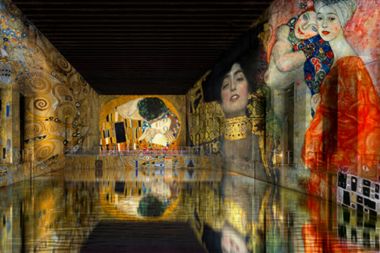Projection at the world’s largest digital art centre
With a 14,000 sqm projection surface including four ponds, the Bassins des Lumieres utilises 30 Modulo Pi media servers alongside 95 Barco video projectors and 80 Meyer Sound loudspeakers.

Inaugurated on 10 June, after a seven-week delay due to the Covid-19 lockdown in France, the Bassins de Lumières in Bordeaux is the largest digital art centre in the world. Established in a former World War II submarine base facing the Atlantic Ocean, the Bassins de Lumières includes four vast ponds, a cube, and an immersive tank for a total projection surface reaching 14,000 sqm.
Due to strict hygiene and social distancing measures in force currently, visitors can only buy tickets online, are temperature-checked at the entrance, and must use masks and hand sanitiser. However, since the building has more than 3,000 sqm of floor space (equivalent to 12 tennis courts), “everyone has at least five square metres of individual space,” director Augustin de Cointet told the Guardian newspaper. “The rules are there, but discreet, as we want everyone to enjoy the full experience.”
In the opening exhibition, the works of Gustav Klimt, Egon Schiele and Paul Klee are projected on to every surface of the base’s four 110-metre-long, 12-metre-high chambers. The projections have already appeared at Culturespaces’ two other digital venues in France, the Atelier des Lumières in Paris and the Carrières de Lumières in Les Baux-de-Provence, but were redesigned for Bordeaux. “Les Bassins has a totally different atmosphere,” says de Cointet. “For one thing it’s gigantic: it is five times larger than the Atelier and three times the size of the Carrières, but what really makes Les Bassins unique is the reflections in the water.”
Beside the huge chambers is Le Cube, a 220 sqm box showing digitalised projections of contemporary art (currently showing Ocean Data by Ouchhh) and a circular cell, the seven-metre-high La Citerne, which allows visitors to lie down and experience the immersive exhibitions from a different viewpoint.
The AV set-up relies on 71 x F80-Q12 and 24 x G60-W10 Barco video-projectors, 80 x Meyer Sound CAL 32 loudspeakers, and 30 x Modulo Kinetic media servers by Modulo Pi.
The Modulo Kinetic system was instrumental throughout the project workflow: it deals with the study, simulation, and management of the edge blending and warping process for a seamless projection across the monumental canvas. Show control is also handled within Modulo Kinetic.
Culturespaces Digital first turned to Modulo Pi and chose the Modulo Kinetic media server solution in 2018, when it created the first digital art centre in Paris, the Atelier des Lumières which now welcomes more than two million visitors a year. Since then, Modulo Kinetic has also become the exclusive media server for each existing or new digital art centre by Culturespaces Digital: the Carrières de Lumières (Les Baux-de-Provence, France), the Bunker de Lumières (Jeju island, South Korea), and now the Bassins de Lumières (Bordeaux, France).
Augustin de Cointet de Fillain, director of Culturespaces Digital and the Bassins de Lumières, said: “Thanks to Modulo Kinetic, technology is no longer an issue. We have a stable and reliable system that frees us from many technical aspects and allows us to focus on what’s essential: art and creation.”
Visit the AV Magazine website to stay up-to-date with all the latest AV industry news.
Posted: 25th June 2020